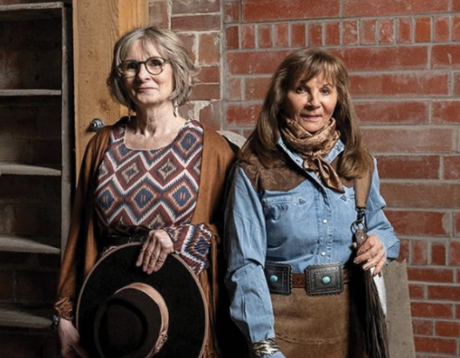
Like a fish drawn to a hook glittering in still, deep waters, his display stood out among the multitude of vendors at the Spruce Meadows Masters. Scott Hardy’s silversmith collection just didn’t grab my attention: it commanded it.
I’ve been a goner?—?hook, line and sinker?—?since that day 17 years ago; a steadfast fan, in awe of the intricate movement, depth of engraving, and beauty of his western silversmith pieces?—?whether it’s a simple D-ring belt buckle or an elaborate whiskey cup set. Scott Hardy is more than a craftsman of cowboy culture, building buckles for the likes of Garth Brooks or Ian Tyson. He is one of North America’s preeminent western silversmiths who has spent half of his 30-year career forging an educational path to help those learn about the four disciplines of the traditional cowboy arts: silversmithing, saddlemaking, rawhide braiding, and bit and spur making.
Horses were Hardy’s first passion growing up as a child in Dundurn, Saskatchewan where he and his cousins spent hours “terrorizing the country, all on a Shetland pony. I can’t remember a day without a horse.”
Horses would also lure Hardy over to Alberta in 1972, after a couple of Banff National Park outfitters came looking to hire experienced ranch kids. “My second night in Banff I was walking across the bridge along Main (Street) at the Bow River. I looked both ways off that bridge and thought, ‘I’m never going back.’”
Hardy was working as a guide for Brewster’s in Lake Louise when he met his future wife Leslie. They married in 1978, eventually settling in Calgary, with Hardy working for his stepfather as a welder. “I knew I didn’t want to stay a welder. I was looking for a way to do something (in order) to start ranching, and the silver seemed to offer the right mix.” So Hardy took a beginning silversmith course at Mount Royal College. While it focused on jewelry, he wanted western craftsmanship. But starting out wasn’t easy.
“I couldn’t get anybody to show me anything. It took me four years to get into the first guy who would teach me for money.” In 1982 Hardy, a newly-wed with no money, took a bus to Milton-Freewater, Oregon for a five-day, $500 workshop with silversmith and saddle maker Cliff Ketchum.
Hardy continued to learn as much as he could. He travelled to top 10 shows such as The Trappings of the American West, in Flagstaff, Arizona that featured master craftsmen Al Pecetti, Mark Drain, and Al Teijen.
Teijen and Pecetti became mentors who told Hardy to focus solely on one skill, advice he took to heart. “I’ve spent 30 years trying to become a great engraver, trying to learn every technique about silver, whether it’s bright cut engraving, filigree, forming, or spinning. If you derail yourself by trying to learn two or three trades by rolling them into one I don’t know anyone talented enough to do a great job at all of them. It doesn’t work.”
Hardy also became friends with Millarville saddle maker Chuck Stormes. Together they would go on to become the only two Canadian founding members of the Traditional Cowboy Arts Association (TCAA) in 1998, a group dedicated to achieving excellence in the traditional cowboy arts. Hardy’s focus during his membership and three-year tenure as TCAA president, has been education.

“People were too secretive about what they were doing. I truly believe we’ve made huge mistakes in western craftsmanship; that’s part of the reason for the TCAA coming into being,” Hardy explains. “I love working with my hands. I’m really productive. But I feel like I have just so much more to achieve and learn. I want to be able to pass that on.” Fortunately Hardy has been able to pass his gift on to both sons, Tyne and Colter; the 28-year-old twins recently started their own custom business, Royal Empire Jewelry.
Don Reeves, the McCasland Chair of Cowboy Culture at the National Cowboy & Western Heritage Museum in Oklahoma City, says Hardy sees the bigger picture of solidifying a market place for future silversmiths such as Tyne and Colter. “He knew how hard it was for him to come up and get the experience and training he needed. There’s only so much of this you can discover by trial and error on your own. He really pushes himself. As a result, he’s grown a great deal in 20 years; he struggles to make his pieces as unique as possible because he has a patronage?—?clients who expect that from him,” says Reeves.
One such patron is Brent McKinley of Arlington, Washington. His personal collection includes 12 individual Hardy pieces and 12 saddles adorned with Hardy silver. Hardy is quick to recognize that the industry grows because of such individuals. “If the collectors didn’t believe in you, support you and cut you loose and say, ‘You just build it and if we enjoy it, we’ll buy it’, we couldn’t do (what we do). None of this works without them.”
While his accolades are too numerous to mention?—?most recently he was commissioned to design and create 100 Calgary Stampede centennial sterling silver and gold belt buckles, in which the buckle’s image turned into a Canada Post stamp?—?Hardy feels his best work is yet to come.
“Every craftsman’s productive years is limited. And good Lord willing, if everything works out, I’ve got another 15 years. I feel like that’s just not enough time. I want to get so much better at what I do. It’s my passion, it’s my pleasure, and it’s my profession. I owe it to the work to take it as far as I can.”
Photos courtesy TCAA/National Cowboy Museum; Hardy Family Collection






















